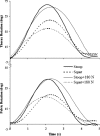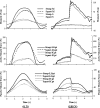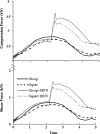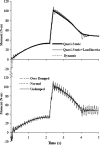Analysis of squat and stoop dynamic liftings: muscle forces and internal spinal loads
- PMID: 17103232
- PMCID: PMC2213554
- DOI: 10.1007/s00586-006-0240-7
Analysis of squat and stoop dynamic liftings: muscle forces and internal spinal loads
Abstract
Despite the well-recognized role of lifting in back injuries, the relative biomechanical merits of squat versus stoop lifting remain controversial. In vivo kinematics measurements and model studies are combined to estimate trunk muscle forces and internal spinal loads under dynamic squat and stoop lifts with and without load in hands. Measurements were performed on healthy subjects to collect segmental rotations during lifts needed as input data in subsequent model studies. The model accounted for nonlinear properties of the ligamentous spine, wrapping of thoracic extensor muscles to take curved paths in flexion and trunk dynamic characteristics (inertia and damping) while subject to measured kinematics and gravity/external loads. A dynamic kinematics-driven approach was employed accounting for the spinal synergy by simultaneous consideration of passive structures and muscle forces under given posture and loads. Results satisfied kinematics and dynamic equilibrium conditions at all levels and directions. Net moments, muscle forces at different levels, passive (muscle or ligamentous) forces and internal compression/shear forces were larger in stoop lifts than in squat ones. These were due to significantly larger thorax, lumbar and pelvis rotations in stoop lifts. For the relatively slow lifting tasks performed in this study with the lowering and lifting phases each lasting approximately 2 s, the effect of inertia and damping was not, in general, important. Moreover, posterior shift in the position of the external load in stoop lift reaching the same lever arm with respect to the S1 as that in squat lift did not influence the conclusion of this study on the merits of squat lifts over stoop ones. Results, for the tasks considered, advocate squat lifting over stoop lifting as the technique of choice in reducing net moments, muscle forces and internal spinal loads (i.e., moment, compression and shear force).
Figures








References
-
- ABAQUS CAE [Computer Program] (2004) United States of America, ABAQUS, Inc. 2004
-
- Adams MA, McNally DS, Chinn H, Dolan P. Posture and the compressive strength of the lumbar spine. Clin Biomech. 1994;9:5–14. - PubMed
-
- Anderson CK, Chaffin DB, Herrin GD, Matthews LS. A biomechanical model of the lumbosacral joint during lifting activities. J Biomech. 1985;18:571–584. - PubMed
-
- Andersson GB. Epidemiologic aspects on low-back pain in industry. Spine. 1981;6:53–60. - PubMed
-
- Arjmand N, Shirazi-Adl A. Sensitivity of kinematics-based model predictions to optimization criteria in static lifting tasks. Med Eng Phys. 2005;28:504–514. - PubMed
MeSH terms
LinkOut - more resources
Full Text Sources

